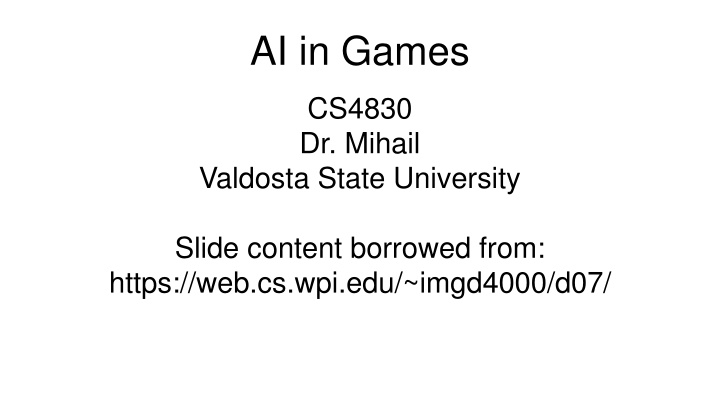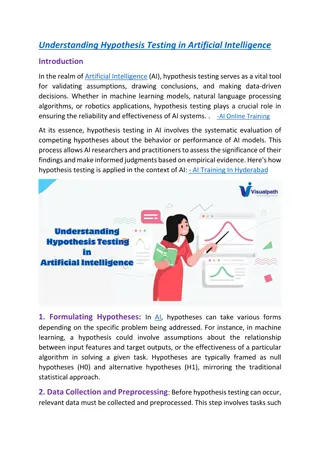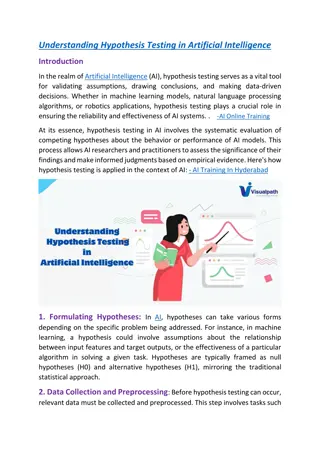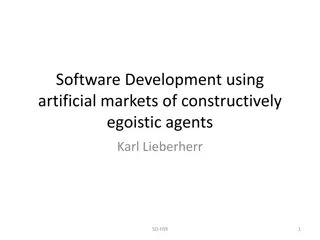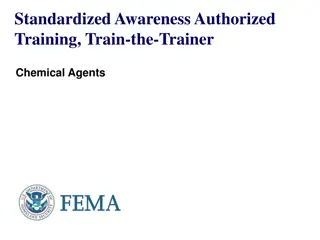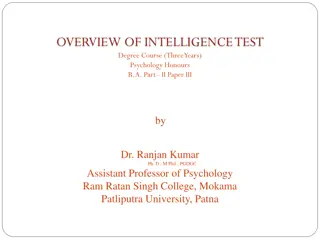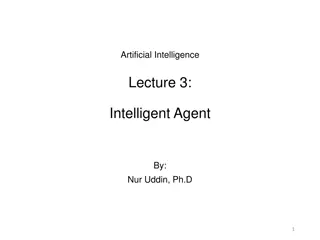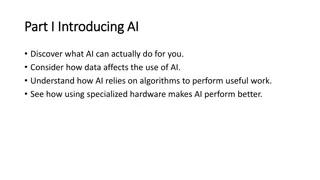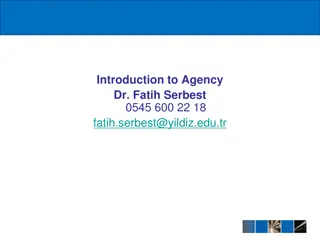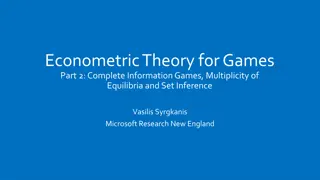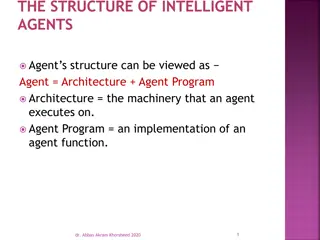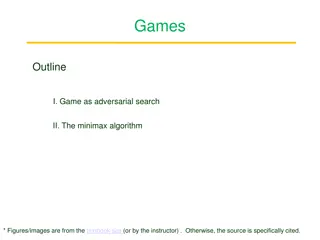Artificial Intelligence in Games: Understanding AI Characters and Agents
Realm of artificial intelligence in gaming, focusing on AI characters' behaviors and agent loops - sense, think, act. Discussing sensing, vision, hearing, and decision-making processes in creating challenging gameplay experiences.
Download Presentation

Please find below an Image/Link to download the presentation.
The content on the website is provided AS IS for your information and personal use only. It may not be sold, licensed, or shared on other websites without obtaining consent from the author.If you encounter any issues during the download, it is possible that the publisher has removed the file from their server.
You are allowed to download the files provided on this website for personal or commercial use, subject to the condition that they are used lawfully. All files are the property of their respective owners.
The content on the website is provided AS IS for your information and personal use only. It may not be sold, licensed, or shared on other websites without obtaining consent from the author.
E N D
Presentation Transcript
AI in Games CS4830 Dr. Mihail Valdosta State University Slide content borrowed from: https://web.cs.wpi.edu/~imgd4000/d07/
Artificial Intelligence Branch of CS that deals with machine decision making and many other things, e.g.: computer vision, speech recognition, fraud detection, natural language processing, load distribution, and many others. AI in games: slightly different Opponents, or units, or NPC (non-player characters) who act on their own Human level performance is too hard
AI characters AI characters must act in specific ways for games to be fun: Smart, but purposely flawed No unintended weakness, must not look dumb Must perform in real time Not hard coded by designer Some AI harder than others given the granularity of their impact:
Agents Game AI focuses around agent e.g.: enemy, ally or neutral Loops through sense-think-act cycle: Sense Think Act
Sensing Collect information about the state of the world: barriers, opponents, objects, health, etc. Needs to be fair, not look at game data and same vision, hearing constraints as the player
Vision CPU intensive Must test visibility (whole or partial) Compute vector to each object Dot product gives angle w.r.t agent s own camera viewing angle If visible, check obstructions (CPU intensive)
Hearing Limit agent s ability given other s actions: Tip-toe vs. running Tunable Not physics based: e.g.: sound wave modeling Bounded by area Reaction time has to be delayed to seem realistic
Thinking Evaluate available information and make decision Generally, two options: Expert systems: hard-coded if-then rules + randomness for unpredictability Search algorithms for optimal choice (e.g., MiniMax)
Expert systems Finite State Machines, decision trees Desirable: natural and simple decisions can be encoded in the domain, e.g.: if enemy is weak, attack, otherwise run Problematic: becomes brittle when too many rules are added Domain of agents is fairly narrow, so it works in most cases
Search Look ahead and decide what move gives best reward e.g.: piece on game board (MiniMax), pathfinding (A*) Works well when full information is available, not so well when many unknowns exist
Machine Learning Evaluate past actions Determine next action given the observed rewards of the past Techniques are promising but currently too much overhead (speed and memory requirements) for most games
Tuning agents Most games offer a difficulty level Must have the ability to tune capabilities FPS bot agent can always make head shot Dumbing down achieved by giving human conditions, e.g.: slow reaction times, make more vulnerable, make mistakes on purpose
FSM example See Enemy Wander Attack No Enemy Low Health No Enemy Flee Abstract model of computation. Formally: Set of states A starting state An input vocabulary A transition function that maps inputs and the current state to a next state
Another example (Egyptian Tomb) Mummy behavior Spend all of eternity wandering in tomb Wandering Far away When player is close, search Close by When see player, chase Make separate states Define behavior in each state Searching Wander move slowly, randomly Hidden Visible Search move faster, in lines Chasing direct to player Define transitions Chasing Close is 100 meters (smell/sense) Visible is line of sight
FSM in practice Three approaches: Hardcoded (switch) Scripted Hybrid
Hardcoded void Step(int *state) { // call by reference since state can change switch(state) { case 0: // Wander Wander(); if( SeeEnemy() ) { *state = 1; } break; case 1: // Attack Attack(); if( LowOnHealth() ) { *state = 2; } if( NoEnemy() ) { *state = 0; } break; case 2: // Flee Flee(); if( NoEnemy() ) { *state = 0; } break; } }
Problems Language doesn t enforce structure Transitions result from polling Event-driven is more efficient Can t easily determine when a state is entered the first time Can t be edited by game designers or players
Alternate Scripting Language AgentFSM { State( STATE_Wander ) OnUpdate Execute( Wander ) if( SeeEnemy ) SetState( STATE_Attack ) OnEvent( AttackedByEnemy ) SetState( Attack ) State( STATE_Attack ) OnEnter Execute( PrepareWeapon ) OnUpdate Execute( Attack ) if( LowOnHealth ) SetState( STATE_Flee ) if( NoEnemy ) SetState( STATE_Wander ) OnExit Execute( StoreWeapon ) State( STATE_Flee ) OnUpdate Execute( Flee ) if( NoEnemy ) SetState( STATE_Wander ) }
Scripting Advantages/Disadvantages Advantages Structure enforced Events can be handed as well as polling OnEnter and OnExit concept exists (If objects, when created or destroyed) Can be authored by game designers Easier learning curve than straight C/C++ Disadvantages
Techniques for movement Flocking Move groups of creatures in natural manner Each creature follows three simple rules Separation steer to avoid crowding flock mates Alignment steer to average flock heading Cohesion steer to average position Example use for background creatures such as birds or fish. Modification can use for swarming enemy Formations Like flocking, but units keep position relative to others Example military formation (archers in the back)
Techniques for movement A* pathfinding Cheapest path through environment Directed search exploit knowledge about destination to intelligently guide search Fastest, widely used Can provide information (ie- virtual breadcrumbs) so can follow without recompute Obstacle avoidance A* good for static terrain, but dynamic such as other players, choke points, etc. Example same path for 4 units, but can predict collisions so furthest back slow down, avoid narrow bridge, etc.
Behavior organization Emergent behavior Create simple rules result in complex interactions Example: game of life, flocking Command hierarchy Deal with AI decisions at different levels Modeled after military hierarchy (e.g., General does strategy to Foot Soldier does fighting) Example: Real-time or turn based strategy games -- overall strategy, squad tactics, individual fighters Manager task assignment When individual units act individually, can perform poorly Instead, have manager make tasks, prioritize, assign to units Example: baseball 1stpriority to field ball, 2ndcover first base, 3rdto backup
Behavior organization Influence map 2d representation of power in game Break into cells, where units in each cell are summed up Units have influence on neighbor cells (typically, decrease with range) Insight into location and influence of forces Example can be used to plan attacks to see where enemy is weak or to fortify defenses. SimCity used to show fire coverage, etc. Level of Detail AI In graphics, polygonal detail less if object far away Same idea in AI computation less if won t be seen Example vary update frequency of NPC based on position from player
Other AI methods Bayesian network A probabilistic graphical model with variables and probable influences Example - calculate probability of patient having a specific disease given symptoms Example AI can infer if player has warplanes, etc. based on what it sees in production so far Can be good to give human-like intelligence without cheating or being too dumb
Other AI methods Decision tree learning Series of inputs (usually game state) mapped to output (usually thing want to predict) Example health and ammo predict bot survival Modify probabilities based on past behavior Example Black and White could stroke or slap creature. Learned what was good and bad.
Other AI methods Filtered randomness Want randomness to provide unpredictability to AI But even random can look odd (ie- if 4 heads in a row, player think something wrong. And, if flip coin 100 times, will be streak of 8) Example spawn at same point 5 times in a row, then bad Compare random result to past history and avoid Fuzzy logic Traditional set, object belongs or not. In fuzzy, can have relative membership (ie- hungry, not hungry. Or in-kitchen or in- hall but what if on edge?) Cannot be resolved by coin-flip
Other AI methods Genetic algorithms Search and optimize based on evolutionary principles Good when right answer not well-understood Example may not know best combination of AI settings. Use GA to try out Often expensive, so do offline N-Gram statistical prediction Predict next value in sequence (ie- 1818180181 next will probably be 8) Search backward n values (usually 2 or 3) Example Street fighting (punch, kick, low punch ) Player does low kick and then low punch. What is next?
Summary AI for games different than other fields Intelligent opponents, allies and neutral s but fun (lose in challenging way) Still, can draw upon broader AI techniques Agents sense, think, act Advanced agents might learn Finite state machines allow complex expertise to be expressed, yet easy to understand and debug
